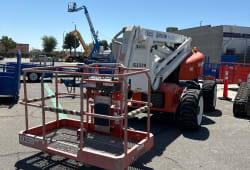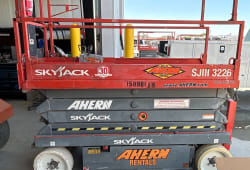Lifting the Load: A Comprehensive Guide to Crane Safety Measures, Types, and Applications
11 Lectura mínima
)
enero 19, 2024
Cranes have a rich history dating back to ancient civilizations. The earliest evidence of crane-like devices comes from ancient Greece, where they were used for construction and to lift heavy objects during various engineering endeavors. During the medieval period, cranes became more sophisticated. Treadwheel cranes, operated by human or animal power, were employed in the construction of cathedrals and other monumental structures. These cranes played a pivotal role in shaping the architectural landscape of medieval Europe.
The Industrial Revolution marked a significant turning point in crane development. Steam-powered cranes emerged, revolutionizing construction and industrial activities. These machines offered increased lifting capacity and efficiency, contributing to the rapid growth of cities and industries.
Importance in Modern Construction
Versatility in Construction
Modern construction heavily relies on cranes for their versatility. Tower cranes, mobile cranes, and specialized cranes are indispensable in erecting skyscrapers, bridges, and other large-scale structures. Their ability to lift heavy loads to great heights streamlines construction processes.
Efficiency and Precision
Cranes enhance construction efficiency by enabling the precise placement of materials and components. Whether lifting steel beams into place or delicately positioning pre-fabricated sections, cranes contribute to the accuracy and speed of construction projects.
Expanding Skyscapes
The skyline of modern cities is a testament to the integral role cranes play in construction. Tower cranes, in particular, dominate urban landscapes, symbolizing ongoing development and growth. These towering machines are synonymous with the dynamic nature of modern cityscapes.
Complex Engineering Projects
In addition to traditional construction, cranes are vital in complex engineering projects. They are instrumental in the assembly of large infrastructure components, such as those used in the energy sector, including wind turbines and power plant installations.
Evolving Technologies
Modern cranes leverage cutting-edge technologies, including computer control systems, telemetry, and automation. These innovations enhance safety, efficiency, and precision in crane operations, marking a new era in the evolution of these indispensable lifting machines.
Basic Components of a Crane
1. Hoist
The hoist is a critical component responsible for lifting and lowering the load. It typically consists of a drum, wire rope, and a hook or other attachment mechanism. The drum winds or unwinds the rope to control the vertical movement of the load.
2. Boom
The boom is the primary horizontal structure of the crane, extending outward from the crane's base. It is essential for reaching and lifting loads to various heights. Depending on the type of crane, the boom may be fixed or telescopic, allowing for adjustable reach.
3. Jib
The jib is an extension of the boom and provides additional reach beyond the initial length. It is especially useful in situations where extra horizontal reach is required, such as over obstacles or confined spaces.
4. Counterweights
Counterweights are strategically placed weights on the crane to balance the load being lifted. They prevent the crane from tipping over by offsetting the weight of the load and the stress placed on the crane during operation.
5. Trolley
The trolley is a mechanism that moves horizontally along the length of the boom or jib. It supports the hoist and allows for precise placement of the load. Trolleys are crucial for optimizing the crane's positioning during lifting operations.
6. Cab or Operator's Station
The cab, also known as the operator's station, is where the crane operator controls and monitors the crane's movements. It provides a vantage point for the operator to ensure safe and accurate operation.
7. Outriggers or Stabilizers
Outriggers or stabilizers are extendable legs that provide additional stability to the crane, especially during lifting operations. They are deployed to widen the crane's footprint, reducing the risk of tipping.
8. Base and Mounting
The base serves as the foundation of the crane, providing stability and support. Depending on the type of crane, the base can be fixed, as in tower crane, or mobile, allowing the crane to be moved to different locations.
9. Mast (for Tower Crane)
In tower cranes, the mast is a vertical structure that supports the entire crane. It is composed of sections that can be added or removed to adjust the height of the crane based on the construction requirements.
10. Hook Block
The hook block is the attachment at the end of the hoist wire rope. It is equipped with a hook or other lifting attachment to secure the load. Different hook blocks may be used based on the type and shape of the load being lifted.
11. Anemometer (for Tower Cranes)
In tower cranes, an anemometer measures wind speed to ensure safe crane operation. If wind speeds exceed safe limits, crane operations may be halted to prevent accidents.
Different types of cranes are available in the market.
There are various types of cranes available in the market, each designed for specific applications and industries. Here's an overview of different types.
1. Mobile Crane:
Hydraulic Truck: Mounted on a truck for easy mobility, suitable for various construction sites.
Rough Terrain: Equipped with large rubber tires, ideal for off-road and rough terrain construction sites.
All-Terrain: Combining the features of hydraulic truck cranes and rough terrain, suitable for both on- and off-road use.
Crawler: Mounted on a set of tracks for stability and mobility on soft ground or uneven terrain.
2. Tower Cranes:
Fixed Tower: Erected on large concrete bases, commonly used in the construction of tall buildings.
Self-Erecting Tower: Mobile and can be transported to various locations; suitable for smaller construction projects.
Luffing Jib Tower: Feature a luffing jib (a hinged arm) that allows for lifting loads while maintaining a compact horizontal reach.
3. Overhead:
Bridge: Installed on elevated runways or tracks, providing horizontal movement with a hoist that can lift and lower loads.
Gantry: Similar to bridge cranes but supported on the ground by legs or wheels, offering mobility within a specific area.
Jib: Composed of a horizontal jib or boom that supports a moveable hoist; ideal for lifting loads within a confined workspace.
4. Specialized:
Floating: Mounted on pontoons or barges, used for marine and offshore lifting operations.
Loader: Mounted on trucks or trailers, commonly used for loading and unloading goods.
Aerial: Helicopter-based cranes used for lifting heavy loads in remote or inaccessible areas.
Straddle Carriers: Designed for transporting and stacking containers in ports and shipping yards.
Caisson: Used in the construction of large, deep foundations for structures like bridges and piers.
5. Telescopic Handlers:
Telescopic Handlers (Telehandlers): Equipped with a telescoping boom, these machines can extend forward and upward, making them versatile for material handling and construction tasks.
1. Mini:
These are Compact and maneuverable cranes suitable for tight spaces and indoor use; often used in maintenance and installation projects.
2. Floating:
Designed for lifting and placing heavy loads onto ships or offshore structures; commonly used in ports.
3. Railroad:
Equipped with flanged wheels for movement on railroad tracks; used for maintenance and construction on railways.
4. Crawler:
Mounted on a set of crawler tracks, providing stability and mobility on soft ground or uneven terrain.
5. Hydraulic:
Utilize hydraulic systems for lifting and maneuvering loads; commonly found in mobile and crawler cranes.
Understanding the different types and their applications is crucial for selecting the right equipment for a specific job. Each type has its own set of advantages and limitations, and the choice depends on factors such as the nature of the project, site conditions, and lifting requirements.
Safety Measures in Crane Operation
Operating a crane involves handling heavy loads in dynamic environments, making safety a top priority. Adhering to stringent safety measures is essential to prevent accidents, protect personnel, and ensure the smooth execution of lifting operations. Below is a detailed overview of key safety measures in crane operation.
1. Operator Training and Certification:
Formal Training Programs: Ensure crane operators undergo comprehensive training programs covering equipment operation, safety protocols, load management, and emergency procedures.
Certification: Operators must hold valid certifications for the specific type of crane they operate. Regular re-certification and ongoing training keep operators current with industry standards.
2. Pre-Operational Inspections:
Daily Checks: Conduct thorough pre-operational inspections to identify potential issues with the crane. Inspect critical components such as hoists, cables, brakes, and safety devices.
Documentation: Maintain detailed records of inspection findings and any maintenance or repairs performed. Documentation is crucial for compliance and tracking the crane's operational history.
3. Load Capacity Guidelines:
Know the Limits: Familiarize operators with the load capacity limits of the crane. Never exceed the rated capacity, and consider factors such as boom length, radius, and operational conditions.
Load Charts: Refer to load charts provided by the manufacturer to determine safe lifting capacities based on the crane's configuration. Update load charts to reflect any modifications or attachments.
4. Communication Protocols:
Clear Communication: Establish and enforce clear communication protocols among crane operators, signal persons, and other personnel involved in lifting operations.
Use of Signals: Standardize hand signals or communication devices to convey instructions between the crane operator and the signal person. Ensure everyone on the worksite understands and follows these signals.
5. Proximity Alarms and Sensors:
Install Proximity Alarms: Equip cranes with proximity alarms or sensors to alert operators to the presence of objects or personnel within the crane's operating radius.
360-Degree Cameras: Consider using 360-degree cameras to enhance visibility and assist operators in monitoring their surroundings, especially blind spots.
6. Weather Considerations:
Wind Speed Limits: Establish wind speed limits for crane operation. If wind speeds exceed safe levels, suspend lifting operations to prevent accidents and equipment damage.
Lightning Safety: Develop protocols for crane operators to cease operations during thunderstorms or adverse weather conditions to mitigate the risk of lightning strikes.
7. Emergency Procedures:
Emergency Stop Systems: Ensure cranes are equipped with effective emergency stop systems. Operators should be trained to respond promptly to emergencies by activating these systems.
Evacuation Plans: Establish and communicate emergency evacuation plans. Personnel should be aware of assembly points and procedures in case of emergencies.
8. Proper Rigging Practices:
Inspect Rigging Equipment: Regularly inspect slings, hooks, and other rigging equipment for wear, damage, or defects. Replace any compromised components immediately.
Load Securement: Properly secure loads using appropriate rigging techniques. Consider the shape, weight distribution, and stability of the load during lifting.
9. Maintenance and Repair:
Scheduled Maintenance: Implement a routine maintenance schedule based on manufacturer recommendations. Regular inspections and preventive maintenance prevent equipment failures.
Prompt Repairs: Address any identified issues promptly. Never operate a crane that requires repairs until it has been deemed safe by qualified technicians.
10. Fall Protection:
Operator Restraints: Provide operators with appropriate restraints or fall protection equipment to prevent them from falling in the event of an accident.
Guardrails and Platforms: Install guardrails and platforms in crane cabs to enhance operator safety, especially when the crane is moving.
Safety in crane operation is a shared responsibility that involves proper training, communication, equipment maintenance, and adherence to industry standards. By implementing and strictly enforcing these safety measures, organizations can create a secure environment for crane operations, ensuring the well-being of personnel and the successful execution of lifting tasks.

Caleb Woods is an experienced content specialist and an editor at Boom & Bucket, blending his journalism background with expertise in the heavy equipment industry. He delivers engaging, informative content to help professionals stay informed and make smarter decisions in the machinery market.











